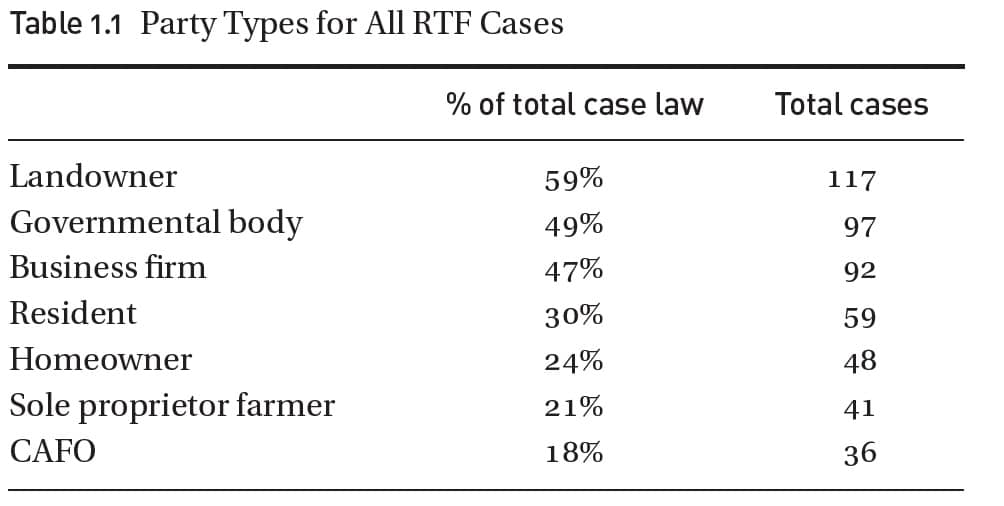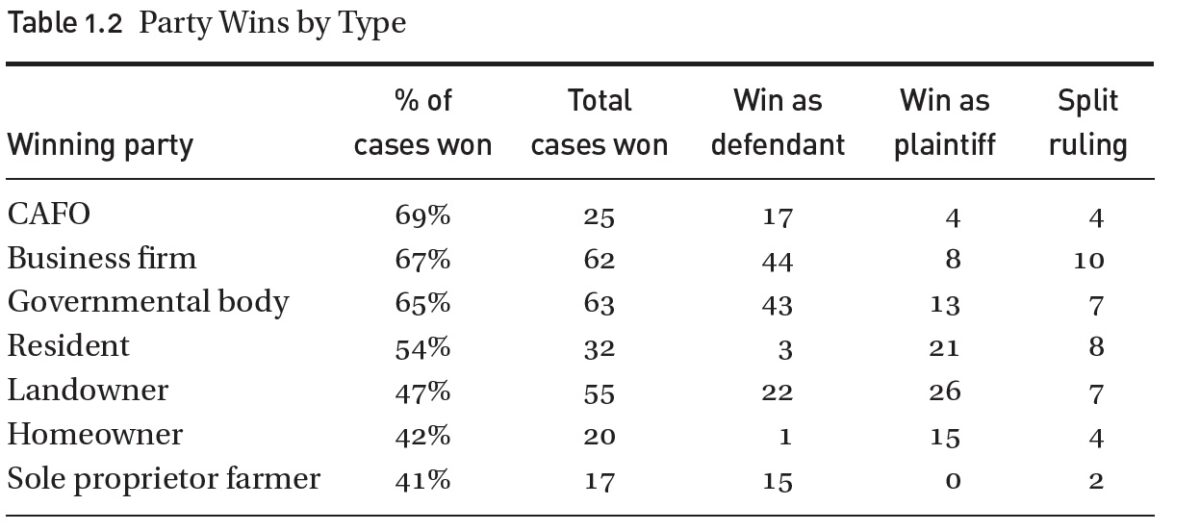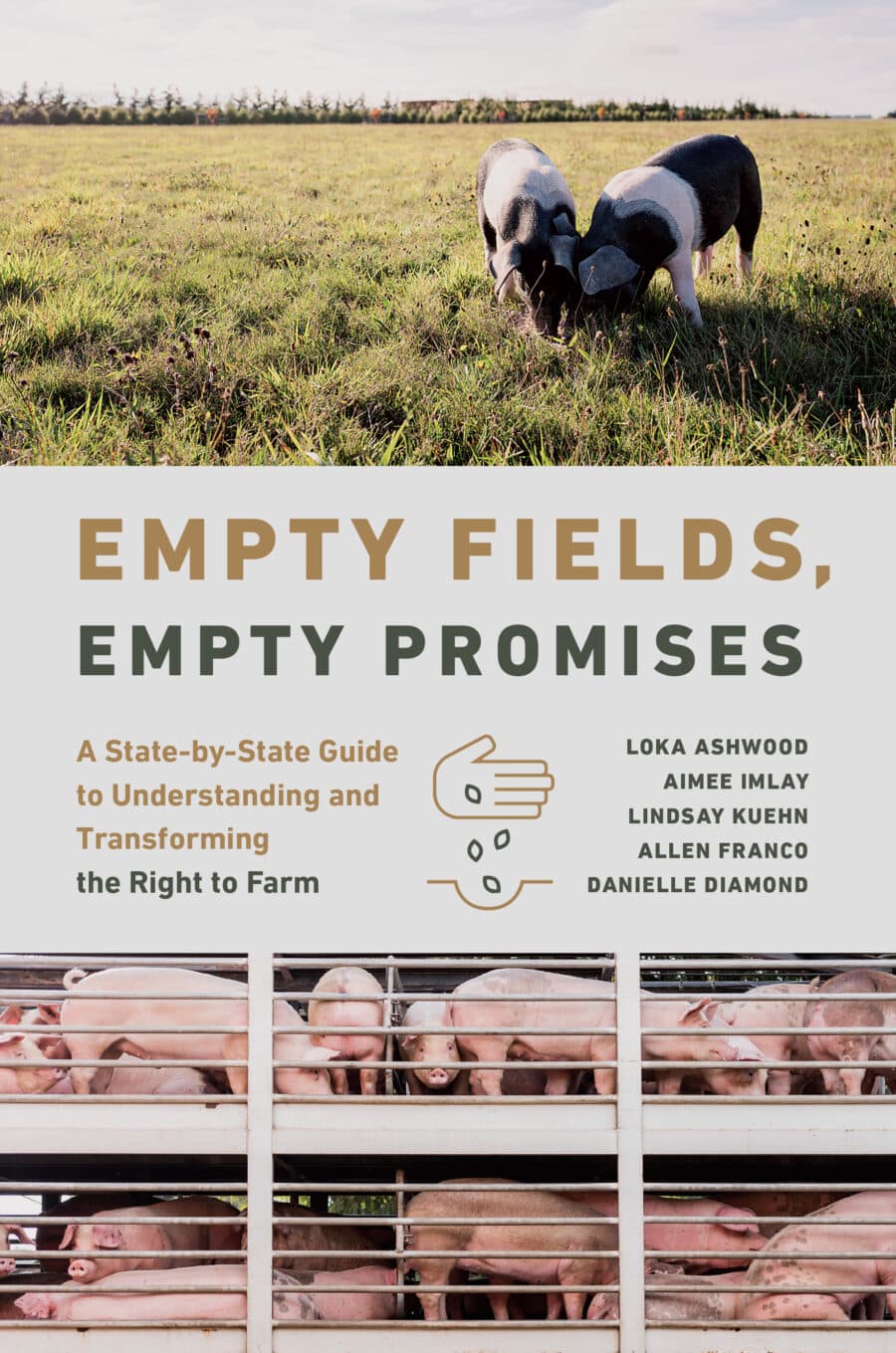First developed in the late 1970s, so-called right-to-farm laws sought to limit nuisance lawsuits loosely related to farming practices. But since their adoption, these laws have greatly expanded in their aim and scope, as influential right-wing organizations like the American Legislative Exchange Council began writing and implementing model right-to-farm bills in states across the nation.
How “Right-to-Farm” Laws Betray Farmers, Disenfranchise Voters and Empower Corporations
Proponents say right-to-farm laws protect family farmers. In reality, right-to-farm laws fuel rural poverty by empowering industrial ag and dispossessing local governance


Empty Fields, Empty Promises: A State-by-State Guide to Understanding and Transforming the Right to Farm offers the first comprehensive analysis of what these laws do and who they benefit. Empty Fields, Empty Promises shows how right-to-farm laws help pave the path to rural poverty by usurping local democratic governance, dispossessing the many in favor of the few. As a result, the book charts a path forward for a more distributed and democratic food system to achieve justice for farmers, rural people and the environment.
For two generations, Paul A. Lewis and his family made White Oak, North Carolina, their home. Mr. Lewis’s mother took her first breath on their 106-acre farm, born on an expanse of land that they—unlike many Black families before them—could proudly call their own. They treasured rural living, outdoor cookouts, hanging clothes on the line and drawing water from their own well.
Mr. Lewis called it “quiet and peaceful” until 1995, when a concentrated animal feeding operation (CAFO) started fattening 14,700 hogs some 600 yards from his home. The stench rushed through the half-mile of timber between his homestead and the hog confinements. The odor and dust particles started clinging to clothes on the line. The cookouts came to a stop. Swarms of flies and other insects gathered around the porch and made their way inside the windows. Dead hogs fell off trucks running in the night. Manure mist and fumes from the lagoon and spray field system made it difficult for Mr. Lewis to breathe. In unfolding years, he was diagnosed with asthma, chronic skin disorders, sinus problems, depression and a suite of other health issues.
It appeared that Mr. Lewis might finally have his day in court when he filed a complaint against the hog operator, Murphy-Brown Limited Liability Company (LLC) in 2020. He did so in defense of his property rights, alleging the pollution was a nuisance that took away the enjoyment of his home and the use of his land. He also sued for negligence, stating that the company knew the harmful effects of its operation but continued anyway. Murphy-Brown’s ultimate beneficiaries traced back to WH Group Ltd., one of the world’s most powerful financial holding companies involved in food production.
Midway across the country, amid the row cropland of Fort Branch, Indiana, Glenn and Phyllis Parker similarly looked to the courts for justice. Like Mr. Lewis, Mr. Parker’s mother had passed the farmland down to him. Together, the Parkers built their lifelong home on the land in 1972, without a second thought to the neighboring 100-head dairy that had been there as long as they could remember. Mr. Parker farmed the land part-time until he retired in 2005 and decided to rent it to a local grain farmer. Five years later, the once-familiar dairy farm added on a 900-head dairy CAFO and incorporated it a stone’s throw away from his home. Less than a year after it became operational, the elderly Parkers filed a nuisance suit, alleging noxious odors and property devaluation.
“The odor lingers in our garage and in our clothes… when we open the backdoor, it reefs into the kitchen,” Mr. Parker said in his deposition. “We often have people who come to visit us and say, ‘How do you stand this?’ ”
Phyllis, whom Mr. Parker had been married to for 54 years, had long suffered from depression, but after the building of the CAFO, it became severe. She could no longer garden and observe the birds, her favorite pastimes that brought her joy.
“You go from a family farm that doesn’t bother anybody to one who makes your life almost unbearable,” Mr. Parker said.
Across differences of geography and race, and similarities of rural living and multigenerational farms, Mr. Lewis’s and the Parkers’ cases shared the same fate. They lost in court, in large part due to what are called right-to-farm (RTF) laws, statutes active in every U.S. state that were often passed with the purported intent of protecting family farms.
But these laws did not protect the Parkers’ and Mr. Lewis’s family farms. Rather, they made them acutely vulnerable, especially in Indiana and North Carolina, two states where CAFOs and business firms like corporations use RTF laws the most to their advantage. What, in fact, are RTF laws? How do they differ across the country? What has their impact been, and whom have they benefited? And, perhaps most importantly, if they are not serving agricultural, rural and environmental justice interests, how can they be reformed for the better?
The History of Right to Farm Laws
RTF laws hit legislative floors during one of the most severe agricultural crises in the history of the United States. In the early 1980s, farmers went out of business in droves and farmer suicides hit record highs as debt soared, land prices collapsed and commodity prices bottomed out as part of the U.S. grain embargo against the Soviet Union. Just as interest rates on farm debts rose in the late 1970s, the first, more explicit RTF laws were enacted in Alabama in 1978, followed by Florida, North Carolina and Washington the next year. By the end of the 1980s, another 42 states would pass RTF statutes enabled by rhetoric that promised support to family farms. By the mid-1990s, the four remaining states would enact them.
The legislators who introduced RTF laws offered them as a saving grace for agriculture and the farmer. Early advocates of RTF laws caricatured the threatening, sue-happy urbanite moving out to the country as unfamiliar with the sights and sounds of agriculture. Likewise, they warned of the litigious lawyer, evoking long-simmering resentment by rural dwellers toward extractive urban centers.
[Right-to-Farm] laws have benefited from division: the eater from the grower, the dweller from the farmer, the feeder from the fed, the agri- from the -culture… [and] benefited the takers—large-scale corporate agribusiness—at the expense of the doers, people who live and dwell proximate to where they grow food.
“Hopefully, this will send a message to the public that if they move next to a farmer, they have to accept how he operates,” said Owen Mohler, then president of the Indiana Farm Bureau in 1987, praising the state’s RTF law.
Under such premises, RTF statutes began to fundamentally change the meaning of private property rights in the United States. Property holders’ constitutional right to the enjoyment and use of their land became subject to RTF laws’ protections of agriculture—as it was defined by each state. Property rights matters formerly subject to the fact-finding authority of the judge in court instead became subject to RTF laws passed by state legislators and the lobbying efforts behind them.
Transnational corporations have advocated for and heralded RTF laws, inflaming urban-rural animosity, but without mentioning their dangerous implications for property rights. Keira Lombardo, Smithfield Foods’ vice president of corporate affairs, claimed in 2019 that the laws served the best interests of family farms. Like Murphy-Brown LLC, Smithfield Foods Inc. also is a subsidiary of WH Group Ltd., a company mostly owned and operated by investors in China. After her company lost RTF-related cases in North Carolina, Lombardo wrote in an email to a reporter that “the negative verdicts have scared family farmers and lawmakers whose states’ livelihoods and fundamental characters depend on agriculture.” She went on to welcome amendments to make it more certain that Smithfield Foods Inc. would win in the future: “Legislation seems like a commonsense reaction to what many understandably perceive to be a threat to their ability to earn a living and cherished way of life.”
Yet only one state in the country, Minnesota, even from the very inception of RTF laws, included family farms anywhere in the statutory provisions passed supposedly in their defense. In its 1982 statutes, Minnesota defined a “family farm” as an “unincorporated farm unit owned by one or more persons or spouses of persons related to each other within the third degree of kindred according to the rules of the civil law at least one of whom is residing or actively engaged in farming on the farm unit, or a ‘family farm corporation.’ ”
Since then, Minnesota has stricken this provision. Like most other states, it now protects agricultural operations, defined as “facilit[ies] and [their] appurtenances for the production of crops, livestock, poultry, dairy products or poultry products.” Some states also insulate the labor and employment practices used by such operations from nuisance suits, demonstrating just how far RTF laws have moved away from the family farms they often purport to protect. While only four states initially insulated agricultural operations’ labor and employment practices from nuisance suits, today over a quarter of all states do so.
Further, 24 states explicitly include processing as part of the agricultural activities and operations protected by RTF laws. This makes doing the work of farming or processing even more vulnerable. During the height of the COVID-19 pandemic, workers at large meatpacking plants—often people of color and immigrants—were subject to dangerous and deadly working conditions. Where RTF laws protect processing alongside labor and employment practices, such workers may face more barriers if they try to seek compensation for hazardous working conditions.
See a state-by-state guide of Right-to-Farm laws.
Terms such as “residence” or “home” are conspicuously absent in the protective provisions provided to farmers in RTF laws today. In effect, RTF laws enable outside capital investment, consolidation and the encroachment of absentee production over that which is place-based. When the Indiana appellate court ruled against the Parkers, the court even viewed a home as oppositional to a farm. The court called their residence “nonfarming” and noted that the residence now “extend[s] into agricultural areas,” even though the house had been there since 1974 and the CAFO was built in 2010.
Originally, the most common statutory provision in 29 states was the extension of immunity from nuisance lawsuits to agricultural operations in the event the locality around them changed. On a surface level, such language appeared to ensure that what was there first, like Mr. Parker’s farming homestead, where a family had lived for generations, could be protected in the face of something like suburban sprawl that came later. Yet no state in the nation explicitly bars industrial or residential development of agricultural land through RTF statutes. However, since the inception of RTF laws, 24 states have included a provision that once an operation is up and running for a year, it is immune from nuisance suits. Because the term “operation” is broadly defined, industrial agriculture operations receive protection even if they were developed after a residential family farm.


For example, in 1980, the Supreme Court of Alabama ruled that Faye Ward Born could not sue the Exxon Corporation’s oil-treating facility for light and odor trespass because her suit was “barred by the one-year statute of limitations.” The court cited Alabama’s RTF law, that “no agricultural, manufacturing or other industrial plant or establishment, or any farming operation facility, any of its appurtenances or the operation thereof shall be or become a nuisance, private or public,” when it “has been in operation for more than one year.” Provisions similar to the Alabama one, combined with a suite of other protections that have been tacked onto RTF laws through ongoing amendments, are used by CAFOs and absentee business firms across the nation to win in court.
These immunity provisions have dramatically increased the power of industrial operators over residential farmers and neighbors. States have moved swiftly to extend additional RTF protections through statutory amendments. For example, only Pennsylvania originally provided agricultural operations immunity from nuisance suits if they used a new technology. Today, another 14 states have adopted similar provisions.
In a 2015 case heard by the Supreme Court of Pennsylvania, 34 property owners—many of them longtime residents—sued farm owners and Synagro Central LLC, and Synagro Mid-Atlantic, described in the ruling as “corporate entities engaged in the business of recycling biosolids.” For three years, the company applied 11,635 wet tons of biosolids to 220 acres scattered across 14 fields proximate to the plaintiffs’ homes. The smell of rotting fish was constant. Their eyes burned and their throats were sore. They coughed and had headaches and nausea. Parents tried to protect their children by confining them indoors. The court ruled, however, that such activities were farming activities consistent with “technological development within the agricultural industry” and were therefore entitled to protection. That included a corporation spreading biosolid waste from the city.
Originally, no state statutes provided explicit protection to operations if the product or activities changed—for example, if a veggie farm turned into a CAFO. Now, 13 states do. South Dakota and West Virginia were originally the only states to protect operations if they stopped operating for a period of time or were interrupted. Now another 11 states have adopted similar provisions. These amendments dramatically extend and transform the protections afforded to so-defined operations, regardless of the long-standing fabric of the communities around them.
Other significant amendments to RTF laws have enabled the concentration and corporatization of agriculture and extended special protections to ostensibly nonfarm industries. The most common amendment to RTF laws since their inception is the provision of RTF protections from nuisance lawsuits to forestry, trees or silvicultural products. Initially, nine states had such a provision. Now, 32 states extend RTF protections to the timber industry. In 1995, a paper mill in Mississippi successfully utilized the RTF defense to avoid culpability for the alleged discharge of dioxin sludge when the court ruled that the timber-derived products produced by a paper mill are a crop.

Another 18 states also amended their laws to shield the use of chemicals, like pesticides, and nutrient application from lawsuits. Dorothy and Joshua Collett of Louisiana tried to sue neighboring timberland companies for damages from chemical exposure to formaldehyde at their home, which they argued gave rise to their severe immunological and autoimmune disorders. The court ruled that the timber companies could use the state’s RTF law in their defense.
Most RTF laws also now have provisions that remove democratic oversight by communities, effectively ensuring that the most dangerous, unfamiliar and often unwanted operations are allowed despite local objections. RTF laws thus impose a form of takings not only on family or individual property rights but also on more collective residential and community self-determination. From the start, 18 states removed to various extents local governments’ power over protected agricultural operations, with provisions like that in Alaska, which since 1986 has allowed RTF laws to “supersede a municipal ordinance, resolution, or regulation to the contrary.” Since their initial inception, another 13 states have likewise followed suit. Thus, ordinances passed by communities that prohibit trucks running at certain hours of the night or that try to limit the size or expansion of operations often become null and void. Today, 31 states have statutory provisions that restrict local governmental decision-making or regulatory authority over agricultural operations, and separately New York removes local government’s power only in agricultural zones.
Taken together, 62% of states use RTF laws to weaken democratic control over land use and siting decisions, sometimes with severe consequences. For example, in Missouri, Lincoln Township attempted to exert oversight over an enormous hog operation through setback requirements for sewage lagoons and finishing buildings. Premium Standard Farms, now another subsidiary of Smithfield Foods Inc., had sited 96 hog confinements and 12 waste lagoons on its 3,084-acre location. “After approval by the vote of the people,” the county sought to exert oversight designed “for the purpose of promoting health, safety, morals, comfort or the general welfare of the unincorporated portion of the township, to conserve and protect property and building values, to secure the most economical use of the land, and to facilitate the adequate provision of public improvements.”

The county’s zoning regulations in agricultural areas permitted feedlots and sewage systems but required lagoons to be at least a mile from residences or dwellings. The county also required that lagoons be bonded for at least $750,000 in case there was a spill or the company went bankrupt (which Premium Standard eventually did). For Premium Standard Farms’ lagoons, that meant $9 million in bonds to ensure each of the 58-acre lagoons holding millions of gallons of hog waste could be accountable in the event local people needed to claim compensation.
Premium Standard Farms refused to comply, and the township responded by suing it for public nuisance. The court concluded in 1997 that the township and the county had no authority to govern as such, because the RTF law protected Premium Standard Farms. The court designated the livestock sewage lagoons and finishing buildings as “farm structures” protected by Missouri’s RTF law. It concluded, then, that the setback and bonding requirements were “impermissible,” as zoning could not impose regulations or require permits for farm buildings and structures. The court added that more generally the township did not have the right to prosecute a public nuisance, removing a crucial form of local governance.
….
Mr. Parker’s deposition was just about over. The questions about the longevity of his wife’s depression, his children’s professions, the value of his house and his history of farming seemed to mercifully be at an end. Mr. Janzen, the Indianapolis attorney representing Obert’s Legacy Dairy LLC and Indiana’s Dairy Producers, thought for a moment he was finished.
“Well, wait a minute,” Mr. Janzen said, deciding that he wasn’t quite through. “I assume that you drink milk; is that right?”
“Very little,” Parker answered.
“Very little?” Janzen returned, incredulously.
“It’s not my—not on my high list of things I like. I’m sorry, but—” Parker didn’t have a chance to finish.
“But you eat dairy products?” Janzen asked.
“Really now,” Mr. Parker’s lawyer interjected, for a moment derailing Janzen’s belittlement. Then he allowed it to continue. “Go ahead.”
“I eat some cheese, it’s pretty hard not to—” Mr. Parker started to answer.
“Okay,” Mr. Janzen interrupted again.
“—if you eat pizza,” Mr. Parker finished.
RTF laws have benefited from division: the eater from the grower, the dweller from the farmer, the feeder from the fed, the agri- from the -culture. In doing so, RTF laws have benefited the takers—large-scale corporate agribusiness—at the expense of the doers, people who live and dwell proximate to where they grow food. By creating a false opposition between the goodness of eating, growing, and living, the largest and most wealthy of operators have been able to sow deep divisions to their acute benefit.
From Empty Fields, Empty Promises: A State-by-State Guide to Understanding and Transforming the Right to Farm by Loka Ashwood, Aimee Imlay, Lindsay Kuehn, Allen Franco and Danielle Diamond. Copyright © 2023 by Loka Ashwood, Aimee Imlay, Lindsay Kuehn, Allen Franco and Danielle Diamond. Used by permission of the University of North Carolina Press. More information at www.uncpress.org.

Loka Ashwood is associate professor of sociology at the University of Kentucky.

Danielle Diamond is a visiting fellow at the Brooks McCormick Jr. Animal Law and Policy Program at Harvard Law School.

Aimee Imlay is assistant professor of sociology at Mississippi State University.

Lindsay Kuehn is a public defender in Ramsey County, Minnesota, and a staff attorney with the Farmers’ Legal Action Group.

Allen Franco is an assistant federal public defender for the districts of Massachusetts, New Hampshire and Rhode Island.
Have thoughts or reactions to this or any other piece that you’d like to share? Send us a note with the Letter to the Editor form.
Want to republish this story? Check out our guide.
More from Barn Raiser









